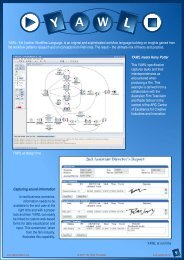YAWL - User Manual - Polytechnic of Namibia - Mirrors
YAWL - User Manual - Polytechnic of Namibia - Mirrors
YAWL - User Manual - Polytechnic of Namibia - Mirrors
Create successful ePaper yourself
Turn your PDF publications into a flip-book with our unique Google optimized e-Paper software.
26 CHAPTER 3. GETTING STARTED WITH <strong>YAWL</strong>“business process management system” if you prefer). Its tongue-in-cheek name belies the fact that <strong>YAWL</strong>is rather unique. It’s based on a very rich workflow definition language, capable <strong>of</strong> capturing all sorts <strong>of</strong>flow dependencies between tasks. It has open interfaces based on Web standards, which enable developersto plug-in existing applications and to extend and customise the system in many ways. It also providesa graphical editor with built-in verification functionality, which helps solution architects and developersto capture workflow models and to automatically detect subtle but potentially nasty errors early-on in thepiece. Finally, <strong>YAWL</strong> is arguably the most mature open-source workflow management system around. Fromits beginnings as an academic prototype, <strong>YAWL</strong> has evolved into an enterprise-grade workflow enginethanks to contributions from the <strong>YAWL</strong> Foundation members, and from the organisations and individualswho have used it. This demonstrated commitment from its users and community <strong>of</strong> developers also ensuresthe continuity <strong>of</strong> the system.If you think <strong>YAWL</strong> might be for you, you may be wondering how to learn more. This chapter provides agentle introduction to the <strong>YAWL</strong> workflow system. The aim <strong>of</strong> the chapter is to help people to get <strong>YAWL</strong>up and running with a minimum <strong>of</strong> fuss. The chapter doesn’t cover all possible features and components<strong>of</strong> <strong>YAWL</strong>. Instead, it focuses on some essential aspects that will help you to become familiar enough with<strong>YAWL</strong> that you feel comfortable designing and executing at least simple workflows. For more information,you may refer to other chapters in this manual, the technical manual or the various academic papers andcase studies available at the <strong>YAWL</strong> web site. 2 .3.2 TerminologyBefore jumping in and getting our hands dirty with a real workflow example, let’s briefly agree on somebasic terms.Business Process: A set <strong>of</strong> interdependent activities that need to be performed in response to a businessevent, to achieve a business objective. Typical examples <strong>of</strong> business processes are “complaint handling”,“order-to-cash”, or “credit card approval”.Workflow Application: A s<strong>of</strong>tware application that co-ordinates the tasks, data and resources that composea business process, in whole or part. Sometimes the term “workflow” is used as a shorthand for“workflow application”.Workflow Specification: (Also known as Workflow Model) A description <strong>of</strong> a business process to the level<strong>of</strong> detail required for its deployment into a workflow engine. A workflow specification defines whichtasks should be performed, under which conditions and in which order, which data, documents andresources are required in performing each task, etc.Workflow System: A system that can be used to develop and to run a workflow application. A workflowsystem usually includes a process editor to support the design <strong>of</strong> workflow models, a workflow engine tosupport the execution <strong>of</strong> workflow models, and at least one worklist handler.Workflow Engine: The runtime component <strong>of</strong> a workflow system responsible for determining which tasksneed to be performed and when, for maintaining execution logs, and for delegating the performance<strong>of</strong> tasks to s<strong>of</strong>tware applications/services or to a worklist handler.Case: (Also known as Workflow Instance) A specific instantiation <strong>of</strong> a workflow model as a result <strong>of</strong> an event.For example, an order management workflow is instantiated every time a new order arrives. Each <strong>of</strong>these orders leads to a different case.Task: (Also known as Activity) A description <strong>of</strong> a unit <strong>of</strong> work that may need to be performed as part <strong>of</strong> aworkflow. Workflow models are composed <strong>of</strong> tasks. Generally, a task may be either manually carriedout by a person or automatically by a s<strong>of</strong>tware application.2 http://yawlfoundation.org





